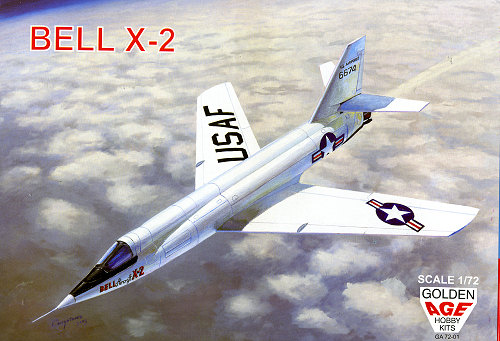
Golden Age 1/72 Bell X-2
| KIT: | Golden Age 1/72 Bell X-2 |
| KIT #: | GA 72-01 |
| PRICE: | $ |
| DECALS: | One option |
| REVIEWER: | Scott Van Aken |
| NOTES: | Short run injected kit. |

| HISTORY |
Providing adequate stability and control for aircraft flying at high supersonic speeds was only one of the major difficulties facing flight researchers as they approached Mach 3. For, at speeds in that region, they knew they would also begin to encounter a "thermal barrier", severe heating effects caused by aerodynamic friction. Constructed of stainless steel and a copper-nickel alloy, and powered by a two-chamber XLR25 2,500 to 15,000 lbf (11 to 67 kN) thrust throttleable rocket engine, the swept wing Bell X-2 was designed to probe this region.
A pair of young test pilots, Captains Iven C. Kincheloe and Milburn G. "Mel" Apt, were assigned the job of further expanding the envelope and, on 7 September 1956, Kincheloe became the first pilot ever to climb above 100,000 ft (30,500 m) as he flew the X-2 to a peak altitude of 126,200 ft (38,466 m). Just 20 days later, on the morning of 27 September, Mel Apt was launched from the B-50 for his first flight in a rocket airplane. He had been instructed to follow the "optimum maximum energy flight path" and to avoid any rapid control movements beyond Mach 2.7. Flying an extraordinarily precise profile, he became the first man to exceed Mach 3 that day, as he accelerated to a speed of Mach 3.2 (2,094 mph, 3,370 km/h) at 65,500 ft (19,960 m). The flight had been flawless to this point, but, for some reason, shortly after attaining top speed, Apt attempted a banking turn while the airplane was still well above Mach 3 (lagging instrumentation may have indicated that he was flying at a slower speed or perhaps he feared he was straying too far from the safety of his landing site on Rogers Dry Lake). The X-2 tumbled violently out of control and he found himself struggling with the same problem of "inertia coupling" which had overtaken Chuck Yeager in the X-1A nearly three years before. Unlike Yeager, however, Apt was unable to recover and both he and the aircraft were lost.
While the X-2 had delivered valuable research data on high-speed aerodynamic heat build-up and extreme high-altitude flight conditions, this tragic event terminated the program before the National Advisory Committee for Aeronautics could commence detailed flight research with the airplane, and the search for answers to many of the riddles of high-Mach flight had to be postponed until the arrival, three years later, of the most advanced of all the experimental rocket planes, the North American X-15.
| THE KIT |
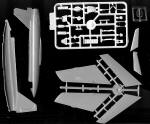 This kit by Golden Age has been preceded in 1/72 by at least two kits that I know of; the X-Planes 1/72 Vacuformed version and the Alliance resin kit. This is the first done entirely from injected plastic.
This kit by Golden Age has been preceded in 1/72 by at least two kits that I know of; the X-Planes 1/72 Vacuformed version and the Alliance resin kit. This is the first done entirely from injected plastic.
I should point out at the very start that this is a short run kit and not to be confused with anything from Tamiya or Italeri. The kit has three full sprues, one in medium grey, one in dirty white and a rather cloudy clear canopy piece. The two fuselage halves and tail planes are separate in the bag. Many of the parts have flash as the molding process is undoubtedly low pressure. Sprue gates are not huge, but they do encroach on the parts themselves, requiring some additional clean up of all the bits. I found the molding to be somewhat reminiscent of Ace or Siga kits.
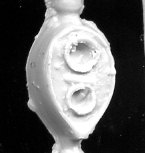
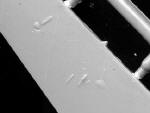 Panel lines are nicely engraved and not 'soft' as one would think. There also seems to be an attempt at a screw-head pattern on many of the panels, but it is somewhat inconsistent and would probably disappear under the first coat of paint anyway. As it is short run, I found some instances of detritus on a few parts, though it was limited to the two images shown. That on the wing will be easy to clean up, but the nozzle part will take more effort. I also found one of the wing skids to be seriously deformed as if it was pushed in while still hot. A nice touch is that the control surfaces are molded onto one wing half, allowing the trailing edges to be nice and sharp.
Panel lines are nicely engraved and not 'soft' as one would think. There also seems to be an attempt at a screw-head pattern on many of the panels, but it is somewhat inconsistent and would probably disappear under the first coat of paint anyway. As it is short run, I found some instances of detritus on a few parts, though it was limited to the two images shown. That on the wing will be easy to clean up, but the nozzle part will take more effort. I also found one of the wing skids to be seriously deformed as if it was pushed in while still hot. A nice touch is that the control surfaces are molded onto one wing half, allowing the trailing edges to be nice and sharp.
The kit includes a fairly nicely done cockpit with raised console details on the tub. A small instrument panel and control stick finish things out. No bang seat on this one. The nose gear well fits under the cockpit tub floor. Really, most of the work will be with the skid on the centerline. There are wing skids as well, but their plac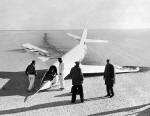 ement is not shown on the wing underside itself and the the instructions are a tad vague on placement. It may well be that these were not standard fare and only used for ground display. Fortunately, the molds do not suffer from any mold shift that one often sees from short run kits so construction should move rather quickly. There isn't much room to put weight in the nose so any needed will probably be best placed behind the cockpit.
ement is not shown on the wing underside itself and the the instructions are a tad vague on placement. It may well be that these were not standard fare and only used for ground display. Fortunately, the molds do not suffer from any mold shift that one often sees from short run kits so construction should move rather quickly. There isn't much room to put weight in the nose so any needed will probably be best placed behind the cockpit.
 Instructions are a single sheet of folded paper with a history, parts layout and four construction steps. Colors are listed in Humbrol, ModelMaster and Revell references with most of the plane being white. Decals are nicely printed, but I think the blue background to the insignia is a bit light. Fortunately, aftermarket insignia are easy to come by.
Instructions are a single sheet of folded paper with a history, parts layout and four construction steps. Colors are listed in Humbrol, ModelMaster and Revell references with most of the plane being white. Decals are nicely printed, but I think the blue background to the insignia is a bit light. Fortunately, aftermarket insignia are easy to come by.
| CONCLUSIONS |
Is it perfect? No, but it is really quite nicely done, especially when one considers it is a low pressure mold short run kit. I have to also confess that I put the X-2 in my top ten for most cool looking planes. I've liked it for as long as I can remember. Perhaps seeing it in William Holden's 'Toward the Unknown' is what caught my fancy. Regardless, we now have an injected version of this very nice plane and I couldn't be more pleased. I do hope that Golden Age decides to do some others of this genre.
| REFERENCES |
November 2007
My thanks to www.olimpmodelsgroup.com for the review kit. Get yours at your local hobby store or ask them to order one for you.
If you would like your product reviewed fairly and fairly quickly, please contact the editor or see other details in the Note to Contributors.